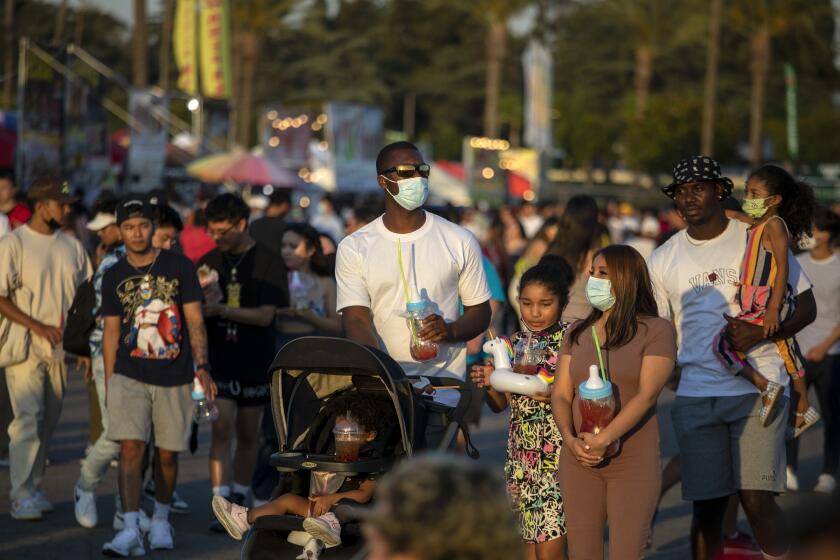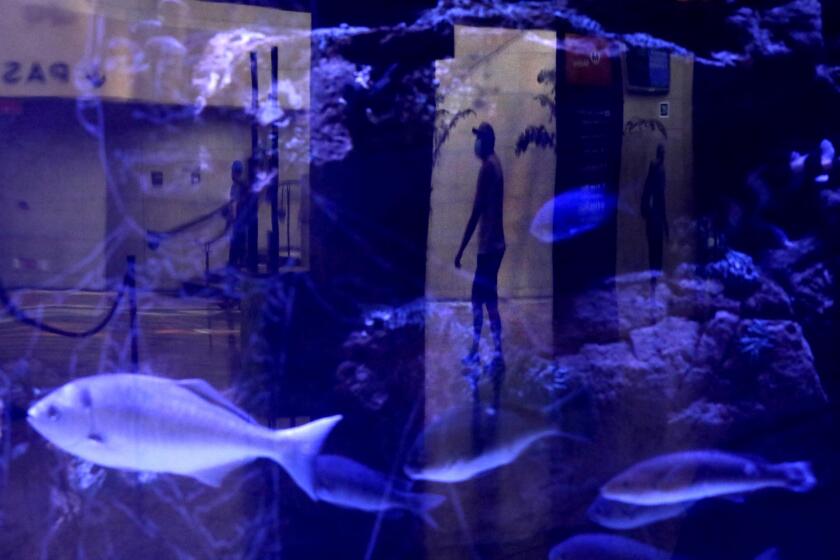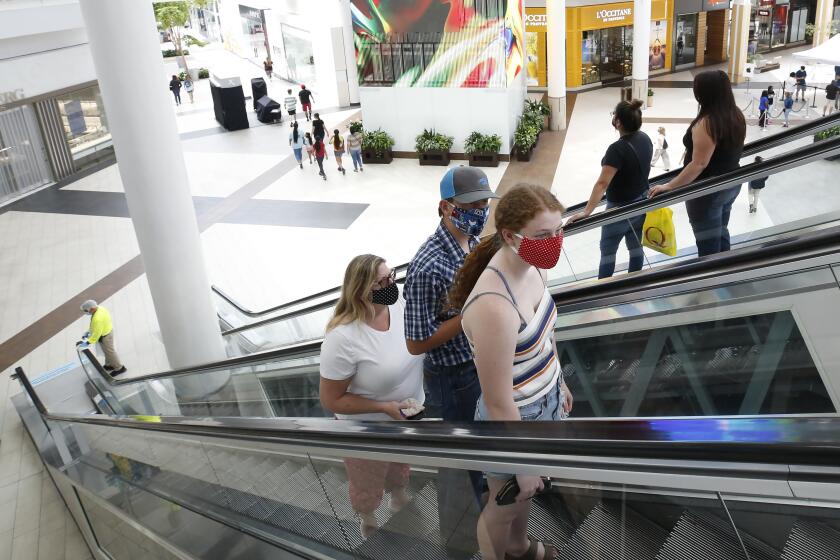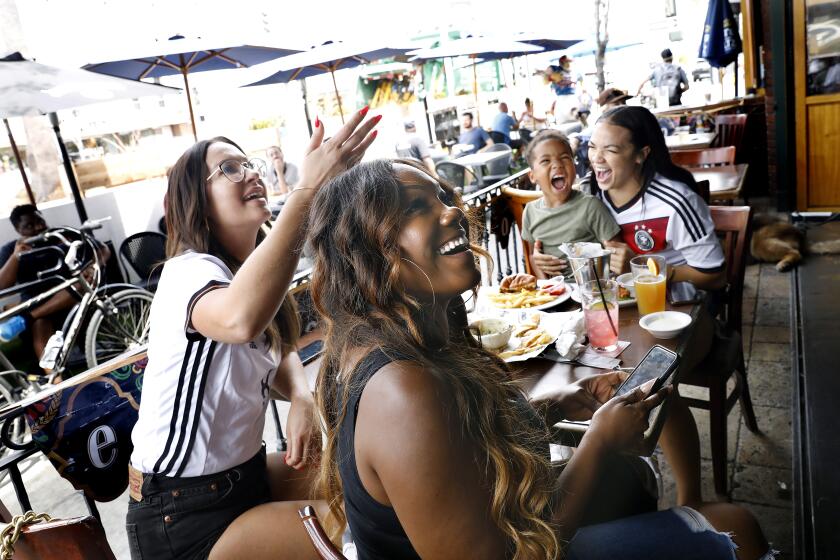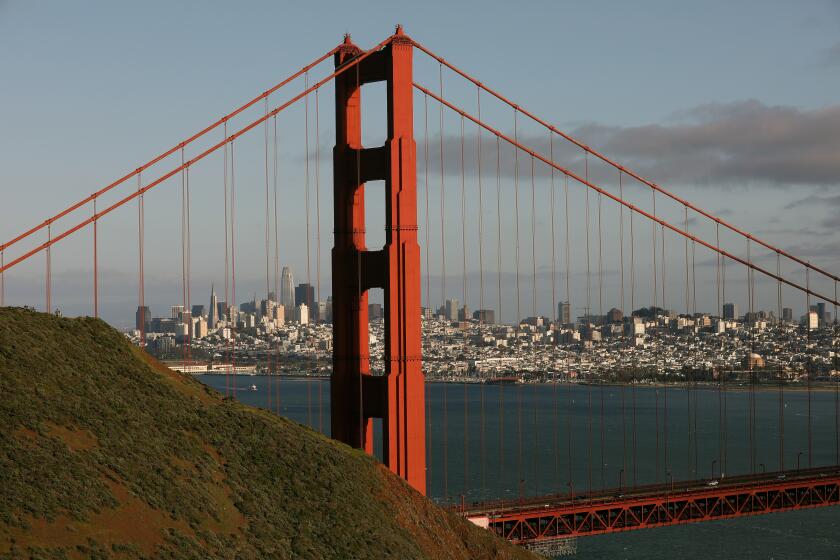With mask mandate, L.A. County now leads national battle against the Delta variant
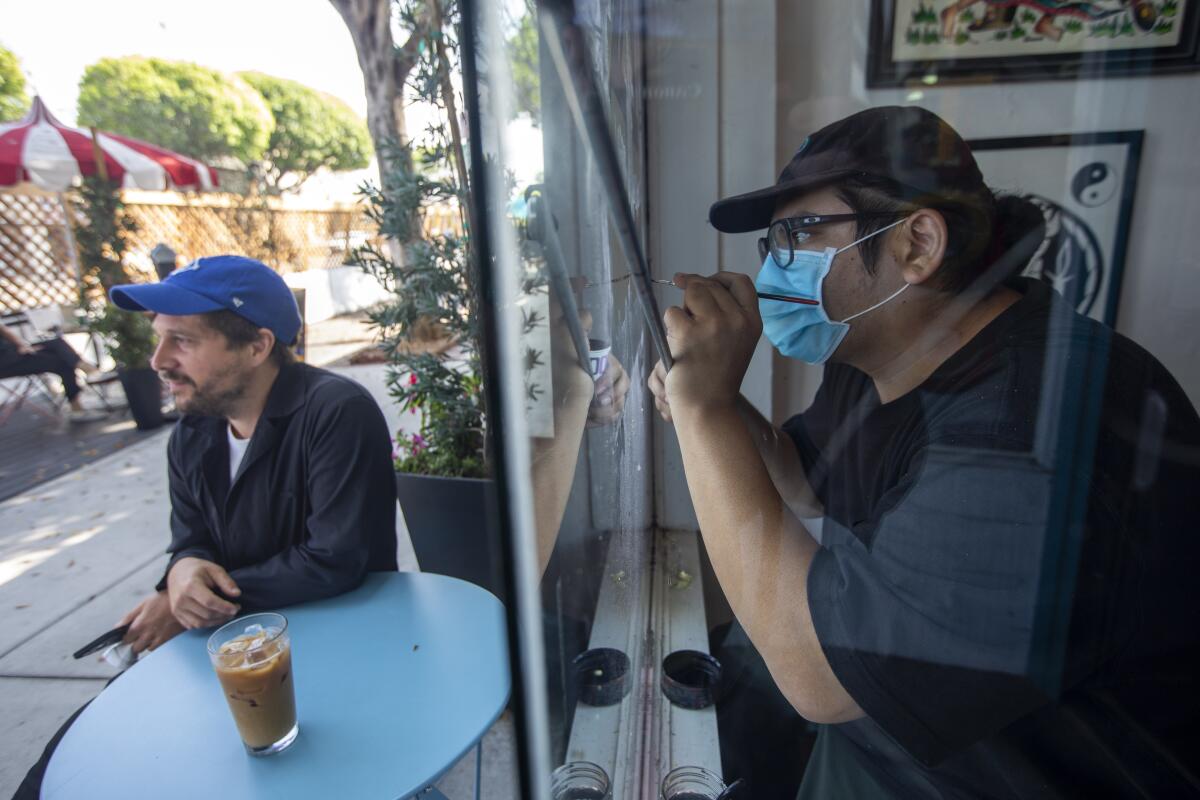
- Share via
By imposing a sweeping indoor mask mandate, Los Angeles County has again pushed itself onto the front lines of the national battle to contain the hyper-contagious Delta variant of the coronavirus.
The easily spread strain has been blamed for increases in infections across the country, and it created a new tightrope for public health officials to walk as they seek to balance the need to protect the unvaccinated while acknowledging that those who are can largely resume pre-pandemic life.
While federal and state authorities continue to urge the unvaccinated to take safety precautions and get their shots, L.A. County has gone a step further: turning to mandatory masking in indoor public settings, even for those who are vaccinated, in hopes of turning the tide.
The effect of the new health order, which goes into effect Saturday night, won’t become clear for a few weeks. Should the strategy prove successful, L.A. County could provide a blueprint for blunting transmission without resorting to the business closures and lockdowns that sparked so much frustration and fear over the last 16 months.
If it fails, though — either on account of public apathy or because it wasn’t aggressive enough — officials acknowledge they may have to take additional action.
“Anything is on the table if things continue to get worse, which is why we want to take action now,” Dr. Muntu Davis, the county’s health officer, said this week.
Officials described the mask mandate as a minimally disruptive tactic to blunt rapidly rising coronavirus transmission. But does it make any sense?
Under the county’s order, effective 11:59 p.m. Saturday, masks will be required to be worn in all indoor public settings, such as theaters, stores, gyms, offices and workplaces, and in restaurants when not eating and drinking. Those exempted include children younger than 2.
There remains much debate about whether L.A. County’s new measures are needed.
Though cases and hospitalizations are on the rise nationwide, officials say new infections and hospital admissions overwhelmingly involve unvaccinated people. In fact, more than 97% of patients entering hospitals nationwide with COVID-19 are unvaccinated, said Dr. Rochelle Walensky, director of the U.S. Centers for Disease Control and Prevention.
Walensky said local policymakers might consider additional masking measures “if you have areas of low vaccination and high case rates,” at least until a community’s vaccination rates improve.
About 52% of L.A. County residents are fully vaccinated, and roughly 60% have gotten at least one shot. But given the region’s enormous population, that still leaves millions vulnerable.
New mask mandate takes effect in L.A. County
Dr. Robert Kim-Farley, medical epidemiologist and infectious diseases expert at the UCLA Fielding School of Public Health, said he’s not worried about the pandemic approaching the same level of devastation seen half a year ago, but is “concerned about the trajectory and the speed of the doubling of new cases.”
He said: “Hopefully, this will be the wakeup call for those who are still vaccine hesitant to roll up their sleeves and get vaccinated.”
Kim-Farley said he did not expect officials to restrict business capacity or reimpose physical distancing measures except as a strategy of last resort.
It’s also unlikely that hospital systems would ever become as strained as they were earlier in the pandemic, he said, “because of the fact that the vast majority of those who are elderly — and at greatest risk of severe disease and death — have been vaccinated. Younger people that are coming down with disease will not have the same high rates of severe illness and death.”
He said L.A. County’s universal mask mandate would probably help deter unvaccinated people from being in public spaces without wearing a mask.
The latest maps and charts on the spread of COVID-19 in Los Angeles County, including cases, deaths, closures and restrictions.
Dr. Peter Chin-Hong, an infectious diseases expert at UC San Francisco, said it’s smart to wear masks in crowded indoor settings, especially “with a bunch of people you don’t know.”
Dr. Monica Gandhi, also an infectious diseases specialist at UC San Francisco, said it can be a reasonable policy to require masks when more than five people are hospitalized for COVID-19 for every 100,000 residents. L.A. County is fast approaching that threshold, now reporting 4.6 hospitalizations for every 100,000 residents; a month ago, it was 2.2.
But Gandhi added that the federal and statewide approach to not require masks for vaccinated people is sound, and demonstrates to vaccine-hesitant people the benefits they can enjoy after getting their shot.
She said she’s concerned that taking away the freedom for vaccinated people to be maskless could further discourage those already reluctant to get their shots.
A recent national survey by the Kaiser Family Foundation found that “a small but meaningful share said the easing of restrictions for vaccinated people made them decide to get a vaccine.”
Chin-Hong said he’s heard from other people who found the call for vaccinated people to resume wearing masks a blow psychologically, as they had hoped COVID-19 was behind them. But “we will continue to be in this boat until people get vaccinated,” he said.
He agreed it was unlikely officials would order businesses to reduce capacity or shut down.
“I think the economy needs to go on — and there are enough people vaccinated,” Chin-Hong said.
There may be regional hot spots in California, but hospitals in other parts of the state will probably be able to lend a hand if one region gets overwhelmed with COVID-19 patients, Chin-Hong said.
Yolo and Sacramento counties recommend keeping masks on while inside.
While other California counties are also taking measures to combat Delta, none has gone as far as L.A.
Earlier this week, Sacramento and Yolo counties called on all their residents to voluntarily wear masks indoors while in public. And a cadre of Bay Area health officials — representing Alameda, Contra Costa, Marin, San Francisco, San Mateo, Santa Clara and Sonoma counties, as well as the city of Berkeley — did likewise Friday, saying in a joint statement that the move would be “an extra precautionary measure for those who are fully vaccinated” and “ensure easy verification that all unvaccinated people are masked in those settings.”
Nearly half of California’s residents, or about 19 million people, now live in counties where health officers are recommending or requiring everyone wear masks in indoor settings.
The Delta variant of the coronavirus has taken on a decidedly American feel, mainly targeting those who just won’t get vaccinated.
Over the last week, L.A. County has reported an average of more than 1,000 new coronavirus cases a day — a tally that, though merely a fraction of the sky-high counts seen during previous surges, is still six times as high as what the county was seeing in mid-June. Daily case numbers have worsened: 1,537 new cases were reported Thursday, and 1,902 more were added Friday.
COVID-19 hospitalizations also doubled over that same time period, from 223 on June 15 to 462 on Thursday. More than 8,000 coronavirus-positive patients were hospitalized countywide during the darkest days of the winter wave.
Requiring masks for all, officials said, provides even more protection to those who are vaccinated while simultaneously ensuring that unvaccinated people can no longer skirt indoor face covering requirements.
Each infection prevented, experts say, is one less chance for the coronavirus to mutate in potentially dangerous ways — as happened with the Delta variant.
That variant, which is believed to be twice as transmissible as the conventional coronavirus strains, is a relative newcomer. But since its presence was confirmed in California in April, it’s rapidly become the state’s dominant strain, and accounted for 48.8% of all cases analyzed in June.
In Davis’ mind, the mask policy also has the benefit of being minimally disruptive to businesses and less confusing for residents.
“There’s a clear, bright line in terms of what needs to be done,” he said. “This is an ‘everybody’ moment in terms of wearing your mask indoors, and it’s something we’ll continue to look at and see how things go. But in general, from what we’ve heard from businesses, it’s easier and better for us to do this and it’s much easier for people to understand.”
With new indoor mask mandate, L.A. County is asking the vaccinated to help the unvaccinated.
For some Angelenos, though, the forthcoming rule is just the latest instance of pandemic-induced whiplash.
“I just think it’s crap,” Vanessa Magaña said before boarding the Metro Gold Line train at the Highland Park stop.
Part of her frustration, she said, was that it seemed like the mask rules were dropped too quickly.
“It was too early to say, ‘No mask anymore,’” she said. Still, she said, “If I have to wear it, I have to wear it. It’s just kind of annoying.”
In Glendale, a man in a red “Scarface” baseball cap who gave his name as Tigran G. said the new rules didn’t make any sense to him.
“What’s the point of being vaccinated if you’re still going to wear a mask?” asked the 25-year-old, who was waiting for a friend down the street from a Starbucks.
He said he hadn’t gotten vaccinated because he hadn’t had time and it seemed “too early” to gauge the side effects.
The mask rules will essentially revert back to where they were before the county lifted them prior to the June 15 reopening.
Some welcomed the forthcoming rule. Brandy Muñiz said the news gave her “a little bit of relief, knowing that number of COVID cases is going up and our vaccination rates aren’t.”
If those trends don’t change, “I’m worried that this could lead back to lockdown,” the 31-year-old said.
Peter Hawks, an apprentice at the Three Kings Tattoo shop on Figueroa Street, said tightening the rules was “long overdue.”
“We shouldn’t have dropped the mask mandate,” Hawks, 26, said while sweeping Friday morning. “It was too early. The city always prioritizes money over health.”
Lillian Castellanos, a cardiovascular technologist who lives in Glendale, said she agrees “100%” with the new, across-the-board rule because it’s impossible to tell at a glance who is vaccinated.
“People that aren’t wearing a mask and haven’t gotten vaccinated — how can you tell?” Castellanos said Friday while walking in Montrose. “It’s not like they’re wearing a sign.”
Outside the South Pasadena Senior Center, Adriana Arroyo sat on a bench, chatting with a friend who gave her name as Mary Ann.
“If they stop at the mask, I’m fine with that,” Mary Ann said. But “stop closing stores, hairdressers ... We’ve gone through enough hysterical shutdowns.”
Doing so would ‘ensure easy verification that all unvaccinated people are masked in those settings,’ officials wrote in a joint statement.
While the prospect of closer-to-normal daily life may be an enticing carrot to some, officials said the resurgence of the coronavirus could also act as a stick.
Over the last week, states with some of the highest case rates in the country — Arkansas, Florida, Louisiana and Missouri — “had a higher rate of people getting newly vaccinated compared to the national average,” according to Jeff Zients, the head of President Biden’s task force on the pandemic response.
“Unvaccinated Americans account for virtually all recent COVID-19 hospitalizations and deaths,” he said during a briefing Friday. “Each COVID-19 death is tragic. And those happening now are even more tragic because they are preventable.”
More to Read
Sign up for Essential California
The most important California stories and recommendations in your inbox every morning.
You may occasionally receive promotional content from the Los Angeles Times.
